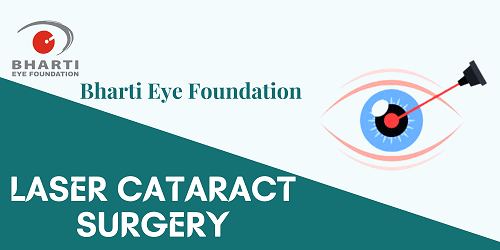Laser Cataract Surgery & Procedure | Bharti Eye Foundation

What Is Cataract Surgery With Lasers?
When the eye’s natural lens becomes hazy, a cataract develops. A small blade is inserted into the front of the eye during traditional cataract surgery, and a different tool is used to make a circular incision on the lens capsule to access the cataract. The cataract is dispersed into tiny pieces by ultrasound pulses, which are then removed. The old natural lens is replaced with the new artificial one.
According to Dr. Horne, a laser creates an incision that is more dependable, reproducible, and precise than even the most talented surgeon can achieve. During laser cataract surgery, a laser is used to make the incision, crack open the lens, and fracture the lens.
Also Read: oculoplasty and aesthetic
How to prepare for the surgery
You should budget one to three hours for check-in, getting ready for the procedure, and postoperative recovery even though cataract surgery only takes around 20 minutes.
After checking in and signing a consent form, you will proceed to the pre-operative area to have your temperature, pulse, blood pressure, respiration rate, and oxygen saturation measured.
Your ophthalmologist and anesthesiologist may consult with you prior to the treatment, and an IV line may be inserted into your arm or hand.
Prior to the Operation
You will be given anaesthetic medicine through an IV to make you sleepy and silent before having local anaesthetic administered into your eye with a needle or as liquid drops to ensure you can’t feel anything when you go into the operating room or suite where your surgery will take place.
It’s possible to clean the region around your eye, apply antibiotic eye drops, and cover your face with a surgical drape.
During the Procedure
A tiny retractor will be put around your eye to help maintain it open while the laser cataract surgery is being done.
Your ophthalmologist will use a laser to create a 2 to 2.5 millimetre (mm) long incision with a negligible vertical and horizontal component.
What the Risks of Getting a Cataract?
Like any surgical procedure, cataract surgery has potentialsues or complications. These a few of those dangers:
- Infected eyes.
- An eye that bleeding.
- Persistent swelling inside or in the front of the eye.
- Retinal enlargement (the nerve layer at the back of your eye).
- Retinal detachment (when the retina lifts up from the back of the eye).
- Injury to your eye’s other components.
- Pain that unresponsive to over-the-counter medication.
- Cloudy vision.
- Observing glare, halos, and deep shadows.
- Loss of vision.
- The IOL implant could slip out of place andcome dislocated.
Other eye diseases including macular degeneration, glaucoma, or diabetic retinopathy will not improved by cataract surgery.
You and your ophthalmologist will discuss the advantages and disadvantages of cataract surgery.
Blades not used during laser cataract operations.
Traditional cataract procedures involve breaking up the cataracts, or hazy lens, with a vibrating needle. They also manually cut an incision in the cornea through which the cataracts removed and replacement lenses placed. Since the incision so small, the eye tissue typically seals itself without even the need for sutures. These approaches haveen employed ofte犀利士
n for many yearscause they typically secure and efficient. This operation performed as an outpatient, lasts around 20 minutes, and recovers quite quickly. Most people immediately return to their regular activities.
Similar to conventional procedures, laser cataract surgeries dissect, remove, and implant new lenses. However, in these treatments, a laser used in place of a hand-held blade to dissect cataracts and make a circular opening where the replacement lens would go. The cataract itself can removed using ultrasound. The recovery process quite similar to that of standard cataract surgery, and the majority of patients report seeing clearly and quickly returning to their regular lives.
Cataract surgery with lasers improves accuracy and precision.
Both conventional and laser operations aim to make incisions as circular as feasible and in the propera in the eye, in addition to properly measuring and fitting the new lens. Most of the time, there no need to remove or replace the implant.
The main distinctiontween the two methods that a precise aperture made in the cornea during laser surgery. According to studies, using a laser to create these apertures approximately 10 times more accurate than doing so by hand. Additionally, astigmatism, an irregularly shaped cornea, treated using laser surgery, which helps to improve eyesight compared to the conventional approach.
Other Helpful Articles:
Posterior Vitreous Detachment and Floaters



